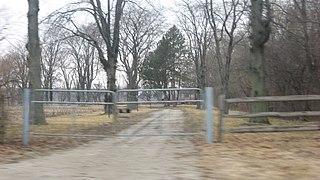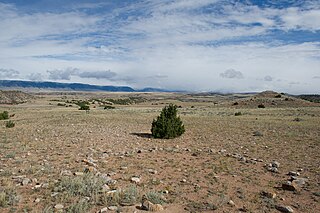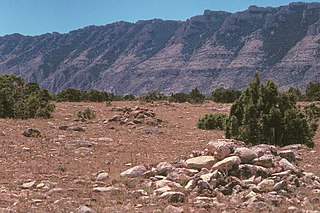Related Research Articles

Independence Rock is a large granite rock, approximately 130 feet (40 m) high, 1,900 feet (580 m) long, and 850 feet (260 m) wide, which is in southwestern Natrona County, Wyoming along Wyoming Highway 220. During the middle of the 19th century, it formed a prominent and well-known landmark on the Oregon, Mormon, and California emigrant trails. Many of these emigrants carved their names on it, and it was described by early missionary and explorer Father Pierre-Jean De Smet in 1840 as the Register of the Desert. The site was designated a National Historic Landmark on January 20, 1961 and is now part of Independence Rock State Historic Site, owned and operated by the state of Wyoming.
The UXU Ranch is a historic dude ranch in Shoshone National Forest near Wapiti, Wyoming. The ranch began as a sawmill, as early as 1898. In 1929 Bronson Case "Bob" Rumsey obtained a permit from the U.S. Forest Service to operate a dude ranch on the property, using the sawmill headquarters building, a lodge, and tent cabins. Most of the current structures were built in the 1920s and 1930s from lumber milled on the site.

This is a list of the National Register of Historic Places listings in Big Horn County, Wyoming.

This is a list of the National Register of Historic Places listings in Campbell County, Wyoming. It is intended to be a complete list of the properties and districts on the National Register of Historic Places in Campbell County, Wyoming, United States. The locations of National Register properties and districts for which the latitude and longitude coordinates are included below, may be seen in a map.

Names Hill is a bluff located on the bank of the Green River in the U.S. state of Wyoming, where travelers on the Oregon and California trails carved their names into the rock. It is one of three notable "recording areas" along the emigrant trails in Wyoming along with Register Cliff and Independence Rock. The site was listed on the National Register of Historic Places on April 16, 1969.
The Agate Basin Site is a Paleoindian archeological site in Niobrara County, Wyoming. The location was discovered by William H. Spencer of Spencer, Wyoming in 1916, who found well-preserved stone blades and points in Moss Agate Arroyo. In 1941 Spencer mentioned the find to Robert E. Frison, a deputy game warden at Newcastle, who visited the site and contacted Dr. Frank H.H. Roberts of the Bureau of American Ethnology at the Smithsonian Institution. Roberts visited the site in 1942, but it would not be until 1959 that a full investigation began by the University of Wyoming on what proved to be a buffalo kill site. Further investigation took place under the direction of Dr. George C. Frison.
The Dead Indian Campsite is an archeological site in the Sunlight Basin of the Absaroka Mountains in Park County, Wyoming, United States. The site was found during the construction of the Sunlight Basin Road in 1967. The location was used as a butchering site, and excavations by the University of Wyoming in 1969 uncovered numerous stone tools, as well as the bones of elk, deer, mountain sheep, porcupine and wolf. A stone cairn was found to contain antler sets. The site was used in different eras for 4500 years.
The HF Bar Ranch is located in Johnson County, Wyoming about 20 miles (32 km) northwest of Buffalo, Wyoming in the foothills of the Bighorn Mountains near Saddlestring, Wyoming. The ranch is a working cattle ranch comprising about 36 buildings, built between 1898 and 1921. The ranch is associated with Wyoming state senator and U.S. Congressman Frank O. Horton, who purchased it in 1911 with financial help from his investment banker brother-in-law and sister-in-law, Warren and Demia Gorrell. The Gorrells and their children spent summers in Wyoming, while the Hortons stayed year-round.

Teapot Rock, also Teapot Dome, is a distinctive sedimentary rock formation and nearby oil field in Natrona County, Wyoming that became the focus of the Teapot Dome bribery scandal during the administration of President Warren G. Harding. The site was listed on the National Register of Historic Places in 1974.

The Dodge Site is an archaeological site in the northwestern part of the U.S. state of Ohio. Located north of Bowling Green in Wood County, the site was inhabited by Middle Woodland and Upper Mississippian peoples. Among the artifacts discovered at the site are ceramics and stone tools. The site's stratigraphy is obvious: the Middle Woodland village site and cemetery can easily be distinguished from the Upper Mississippian occupation zone that sits on top of it. While only a small portion of the 2.2 acre (0.89 ha) site has been excavated, the artifacts that have been discovered at Dodge have contributed significantly to an understanding of the western basin of Lake Erie around AD 1300. Enough material has been recovered to facilitate radiometric dating, as well as identifying the peoples who once inhabited the site. The excavations also revealed the intensity of occupation: the Middle Woodland layer was substantially larger than the exceptionally thin Upper Mississippian component.
The Triangulation Point Draw Site is an archeological site in Uinta County, Wyoming. The camp was occupied by Native Americans from both the Great Basin and the northwestern Plains during the Late Prehistoric period. Surface artifacts found at the site include chipped stone points and tools, ground stone tools, fire locations and organic stains. Buried artifacts include fire rings and habitation-related disturbances. Projectile points at the site include Plains side-notched, Rose Spring corner-notched and Late Prehistoric corner-notched points, as well as a Late Prehistoric small corner-notched point similar to those found in Mummy Cave, more than 200 miles (320 km) to the north.

Tipi rings are circular patterns of stones left from an encampment of Post-Archaic, protohistoric and historic Native Americans. They are found primarily throughout the Plains of the United States and Canada, and also in the foothills and parks of the Rocky Mountains.

The Bad Pass Trail, also known as the Sioux Trail, was established by Native Americans on the border of present-day Montana and Wyoming as a means of access from the Bighorn Basin in Wyoming to Bison-hunting grounds in the Grapevine Creek area of Montana. Marked by stone cairns, the trail led across Bad Pass and was established in pre-Columbian times. After Europeans arrived in the area it was frequented by fur trappers and mountain men, beginning in 1824. Trappers assembled pack trains at the junction of the Shoshone River and the Bighorn River, using the Bad Pass Trail to avoid Bighorn Canyon. The trail ended at the mouth of Grapevine Creek on the Bighorn, from which the pack train could float down the Bighorn on rafts to the Yellowstone River and then to the Missouri and on to St. Louis.
The Hanson Site includes two separate areas of Paleoindian acheological sites in the northern Bighorn Basin of Wyoming, United States. The southern Hanson I site was investigated first in 1973, finding evidence of tool working and stone flakes at a campsite. The northern Hanson II site is larger and includes the sites of lodges. Activity in these areas dates to 10,700 +/- 670 years ago to 10,080 +/- 300 years ago. The Hanson site is also of interest in paleontology, with animal fossil remains at deeper levels. The site was placed on the National Register of Historic Places on December 15, 1978.
The Southsider Shelter is a Native American rock shelter archeological site on the east side of the Bighorn Basin in Big Horn County, Wyoming, United States. The site has occupied from the late Paleoindian period to the Late Prehistoric period. Artifacts include projectile points and chipped stone. The site was added to the National Register of Historic Places on August 1, 2012.
The Garrett Allen Prehistoric Site is an archeological site in Carbon County, Wyoming. The site was used in the Late Middle Prehistoric Period and into the Late Prehistoric Period. The site was used as an animal butchering location. Excavations by George Frison in the late 1960s and early 1970s revealed a continuous series of layers containing tools, stone flakes and projectile points. This site was placed on the National Register of Historic Places on August 7, 1974.
The Muddy Creek Archeological Complex is an archeological location Carbon County, Wyoming. The complex's three sites are dated to the Late Plains Archaic period. Stone points place the users of the site in the Besant Cultural Complex, representing one of the southernmost Besant sites. The sites were was bison hunting and processing locations and feature many bison remains, as well as tipi rings. The complex was placed on the National Register of Historic Places on May 16, 2012.
The Dean Decker Site is an archeological site in Sweetwater and Fremont counties in Wyoming. The site extends for 6.5 kilometres (4.0 mi) along the terraces of Red Creek and Lower Sand Creek, with many Native American hearths and worked stone fragments. The site appears to have been used from the Middle Archaic Period to the Protohistoric Period. It was added to the National Register of Historic Places on March 12, 1986.
The Eldon-Wall Terrace Site is an archeological site in Sweetwater County, Wyoming. The site occupies about 600 metres (2,000 ft) of a terrace on Blacks Fork in the Green River Basin. The site includes numerous hearth sites, with stone chips and tools. A projectile point dates the site to the Middle Archaic period. The site was listed on the National Register of Historic Places on December 13, 1985.
The Green Mountain Arrow Site is an assemblage of arranged stones in Fremont County, Wyoming. The site includes seven stone cairns, a 50-metre (160 ft) directional arrow, three possible stone circles and lines of small stones. It is one of relatively few stone effigies found in the northern Great Plans and Rocky Mountains.
References
- 1 2 "National Register Information System". National Register of Historic Places . National Park Service. March 13, 2009.
- 1 2 "Basin Oil Field Tipi Rings". National Register of Historic Places. Wyoming State Preservation Office. June 10, 2009.